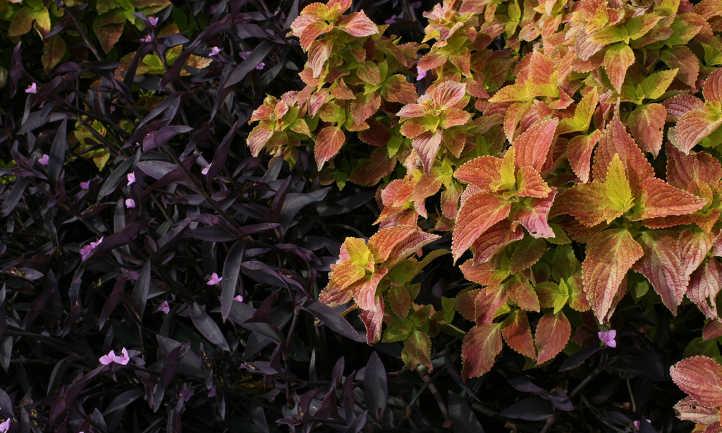Is it possible to grow wandering jew plant outdoors? Absolutely. It started there, after all!
But there’s some tricks to growing these plants so they thrive in an outdoor setting. Let’s talk about the best ways to provide for your Tradescantia-species plants. All wandering jew plants are similar in their requirements, so these tips will work for all types.
You are watching: Wandering Jew Plant Outdoors? Yes, It’s Possible!
Temperature and Climate Needs

In their native habitat, the wandering jew plant tends to prefer warmer climates. Temperature ranges between 50-80 degrees are perfect.
During winter, temperatures in the 45 degree range are a time to be cautious. They can tolerate it for short periods of time, but too long and the plant will start to die. A cold frame can help keep your plant’s ambient temperature above 50 degrees.
If it looks like there’ll be a sudden frost, and you lack a cold frame, a piece of woven cloth can help. Most cloth will only provide 2-5 degrees of warmth, but it’s better than nothing at all.
As for heat, wandering jew loves warm days. But when it’s over 90 degrees, they’re going to need much more frequent watering. A little shade during the hottest part of the day is helpful.
Wandering jew plant outdoors is best placed in a spot where it stays between 50-80 degrees most of the year. Provide a bright, but partially-shaded environment, and your plant will be thrilled.
Potted or Ground Planting?

Read more : Step-by-Step Guide to Outdoor LED Strip Light Installation
But where should you plant your wandering jew plant outdoors? That’s another really important thing to take into consideration.
If you’re planting them outside, you’ve got two realistic options. Mobile containers might be best if your winter temperatures are too cold. These can live outdoors from the spring through the fall and move inside for the winter.
If you’re in USDA growing zones 9-11, you’re in luck. It seldom gets cold enough there for the plants to be in danger. They’ll be safe year-round in that climate range.
Either way, you want your plants to have partial shade during the day. Too much sun can cause the leaves to bleach out and lose their distinct coloration. They can also experience sunburn.
Avoid placing them in total shade as well. They do need some sunlight! Bright, indirect sunlight is best for these plants. A covered porch or patio that gets lots of light during the day is fantastic. With too little light, the plants will send runners towards the nearest bright area, making them uneven and scraggly-looking.
These plants thrive in moist soil. If planting in the ground, be sure to mulch around them to keep the soil moisture consistent. For potted plants, use a potting soil that retains lots of moisture. Mulch the top as well.
Wandering jew plants look amazing in hanging containers, too. You can opt for one of the hanging baskets with a coconut coir liner, like these Rocky Mountain Goods Hanging Flower Baskets. The liner will help hold extra moisture. But you’ll still need to water hanging pots often, as all that airflow will dry them out fast. When the top 1/2″ of soil is dry, water again!
Providing damp soil also ensures that they get the humidity that they prefer. An occasional misting of the leaves doesn’t hurt, and can provide additional moisture they crave.
Maintaining Wandering Jew Plant Outdoors

Read more : How to trim dead plant leaves
Tradescantia species plants do tend to wander, as their name would insinuate. If given half a chance, they’ll spread rapidly. In fact, they’ve become almost invasive, taking over spaces inhabited by other plants!
It’s important to be sure that if you’re growing yours outdoors, you avoid this problem. If placed in the ground, be sure to prune them before they can spread into other beds.
Pruning at a stem joint can provide you with new plants. Keep a glass of water next to you as you’re pruning, and select healthy stems to put in the water. Every day, rinse off the stems and dump and replace the water. Roots should grow within a couple weeks.
Container-planted wandering jews will try to wander, too. While their long stems look great in hanging baskets, other pots should get pruned. This keeps them the right size for their available soil and moisture level.
What About Wildlife?

Do your dogs have free run of the yard? How about your cats, or for that matter any ferals in the area? Are deer prone to nibble on your foliage?
If so, you may want to rethink wandering jew near animals. While deer aren’t prone to go onto your covered patio, they will graze on your bushes. Dogs get anywhere on the ground. Cats… well, they go wherever they want to go! And when growing wandering jew plant outdoors, that’s an issue.
Tradescantia plants tend to cause a dermatitis-like reaction in most dogs and cats. Livestock and wildlife may also be susceptible to this. If your garden is optimized for wildlife to cruise by, you should keep this in mind when planting. Put your plants somewhere out of reach.
Wandering jew plants outdoors are definitely an option! Just be sure you’re prepared for the elements, and place them in the right spot. What’s your favorite wandering jew variety? Let me know in the comments!
Source: https://gardencourte.com
Categories: Outdoor


